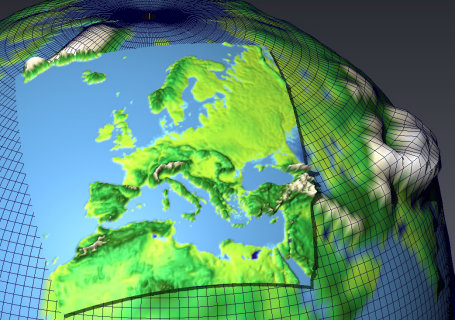Kopplung: Ozean-Atmosphäre
Globale gekoppelte Modelle der Atmosphäre und des Ozeans (Atmosphere-Ocean General Circulation Model - AOGCM) werden seit langem entwickelt und betrieben. Die intensive Entwicklung regionaler gekoppelter Modelle begann dagegen erst in dem letzten Jahrzehnt, und sie wurden nur relativ selten eingesetzt. Ein Grund hierfür besteht darin, dass regionale gekoppelte Ozean-Atmosphäre-Klimasystemmodelle deutlich komplexer sind. Zum einen ist eine Randwertdefinition notwendig, d.h., die prognostischen Variablen müssen an den Rändern des regionalen Modellgebietes vorgeschrieben werden. Zum anderen haben die ozeanische und die atmosphärische Modell-Komponente oftmals eine unterschiedliche Konfiguration, d.h. sie haben unterschiedliche Gitter und eine unterschiedliche regionale Ausdehnung. Die Kopplung der regionalen Klimasystem-Modellkomponenten ist aus diesem Grund sehr schwierig und aufwändig. Weiterhin müssen die regionalen Ozean- und Atmosphären-Modellkomponenten sowohl im gekoppelten als auch im ungekoppelten Modus Berechnungen durchführen können.
Hinzu kommt, dass gekoppelte Ozean-Atmosphären-Modelle nicht notwendigerweise bessere Ergebnisse liefern als ihre ungekoppelten ’stand-alone’-Modellvarianten. Der Grund hierfür ist, dass die Modelle im ’stand-alone’-Betrieb weniger Freiheitsgrade haben als das gekoppelte Modellsystem: Eine wichtige Eigenschaft gekoppelter AOGCMs ist die freie Entwicklung der oberflächennahen Parameter, wie z.B. der Temperatur an der Meeresoberfläche (SST) oder der Lufttemperatur in 2 Metern Höhe. Über die Kopplung wird der Austausch von Impuls (Wind, der Ozeanströmungen antreibt), Energie (Wärme) und Masse (Niederschlag und Verdunstung) zwischen Ozean und Atmosphäre realisiert.
In ungekoppelten globalen Zirkulationsmodellen der Atmosphäre (Atmosphere General Circulation Model – AGCM) bzw. globalen Zirkulationsmodellen des Ozeans (Ocean General Circulation Model – OGCM) werden die oben genannten Felder meist auf Basis von Beobachtungsdaten vorgeschrieben. Daher weichen ungekoppelte Modelle in der Regel nicht so stark von Beobachtungen ab und sind eher in der Lage, ein korrektes Klima an der Grenzfläche Ozean-Atmosphäre zu reproduzieren.
Andererseits können mit einem gekoppelten regionalen AOGCM (Atmospere Ocean General Circulation Model) verbesserte Berechnungen der Klimaänderung durchgeführt werden (“added value”). Zum Beispiel ist die SST, die aus den globalen Modellen ermittelt und danach für die Regionalisierung der Klimaprojektionen (Abb.1a) verwendet wird, viel zu grob für eine regionale Skalierung. Diese Felder können jedoch mit dem Durchlauf eines regionalen atmosphärischen Modells, gekoppelt mit einem regional hochaufgelösten ozeanischen Modell, deutlich verbessert werden (Abb.1c).
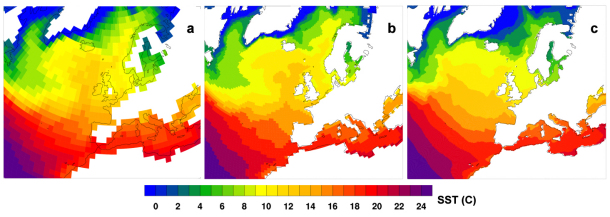
Abb.1 Mittlere SST berechnet bei ECHAM5 T63 gekoppelt mit MPIOM (a), dieselbe SST auf dem originalen MPIOM Gitter (b) und die SST von dem regional gekoppelten MPIOM/REMO mit erhöhter Ozeanmodell-Auflösung im Bereich der Nordeuropäischen Schelfe (c).
Kopplung
In Abb.2. ist eine regionale Kopplung zwischen AGCM und OGCM schematisch dargestellt. Es handelt sich hierbei um ein kompliziertes Beispiel, denn das Modellgebiet des Ozeans (global) ist größer als das Modellgebiet des regionalen Atmosphärenmodells.
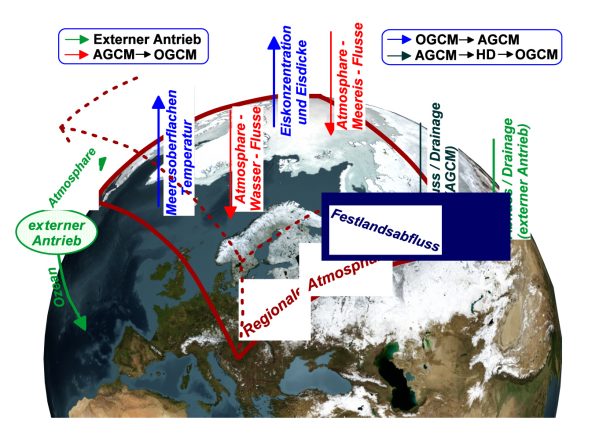
Abb. 2 Schematische Darstellung der Kopplung Ozean – Atmosphäre
Die dynamischen-, Wärme- und Süßwasserflüsse werden im atmosphärischen Modell für offenes Wasser und für den mit Eis bedeckten Teil auf jeder Gitterbox separat berechnet (Legutke and Voss 1999). Vereinfacht können diese folgendermaßen dargestellt werden:

.
Die hochgestellten Indizes bezeichnen die Flüsse des offenen Wassers (W) und die Flüsse über dem Eis (I). Die unteren Indizes bezeichnen den kurzwelligen Netto-Strahlungsfluss (SW), den langwelligen Netto-Strahlungsfluss (LW) sowie den sensible- (S) und latenten (L) Wärmefluss. Für den mit Eis bedeckten Teil gibt es zwei zusätzliche Quellen: den konduktiven Wärmefluss (C), welche für das Wachstum des Eises verantwortlich sind und den residualen Wärmefluss (R'), welcher das Schmelzen des Eises beschreibt. Bei den Frischwasserflüssen wird zwischen flüssigen (W) und festen (I) Anteilen unterschieden:

.
Pt steht für die gesamten Niederschläge, Psn für den Schneefall, Ew für die Oberflächenverdunstung, Pi für Sublimierung des Meereises und Ei für die Eiskonzentration. Impulsflüsse errechnen sich aus dem Luftdruck an der Meeresoberfläche und aus der Windschubspannung. Die Windschubspannung wird separat für offenes Wasser und für eisbedecktes Wasser berechnet.
REMO/MPIOM Kopplung und Einstellung
Die Kopplung für REMO/MPI-OM geschieht mit Hilfe der Kopplungssoftware OASIS, welches vom Centre Européen de Recherche et de Formation Avancée en Calcul Scientifique - CERFACS entwickelt wurde (Valcke et al. 2000). Das Kopplungsverfahren ist dem sehr ähnlich, das vom Max-Planck-Institut für Meteorologie für das globale Klimamodell genutzt wird (Legutke and Voss 1999) und wird in Abb. 1 kurz zusammengefasst. Abb. 3 zeigt verschiedene REMO- und MPIOM-Konfigurationen, mit denen das nordarktische und nordatlantische Klima simuliert wurde.
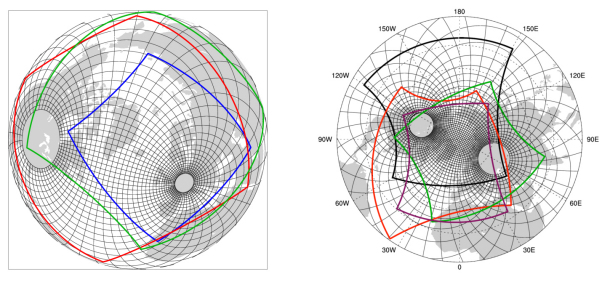
Abb. 3 Gebiete gekoppelter MPIOM/REMO Simulationen. Links: Nord Europa and Nordatlantik, rechts: Arktis. Farbige “Rechtecke” – verschiedene REMO Gebiete, schwarze Linien – MPIOM Gitter
Beispiel: Regionalisierung der IPCC A1B Szenarien für die Ostsee und die Nordsee
Für die Regionalisierung der IPCC A1B Szenarien wurde eine REMO/MPIOM-Konfiguration verwendet, die in der linken Spalte von Abb. 3 abgebildet ist. Im Folgenden werden Resultate vorgestellt, die mit der blau markierten REMO-Konfiguration (siehe Abb. 3) durchgeführt wurden.
Die atmosphärischen Randbedingungen für die seitlichen REMO Modellgrenzen sowie die „unteren“ ozeanischen Randbedingungen, wurden aus dem grob aufgelöstem ECHAM5/MPIOM-Modellsystem genommen. Zunächst wurde das regional gekoppelte Modellsystem mit Antriebsdaten von 1920 bis 2000 aus dem historischen C20 Lauf des grob aufgelösten ECHAM5/MPIOM-Modelles ’eingeschwungen’, um ein Abdriften des Modells zu vermeiden. Unter der Einschwingzeit eines gekoppelten Ozean-Atmosphärenmodells ist der Zeitraum zu verstehen, den das Modell benötigt, damit alle Prozesse, die in dem Modell miteinander wechselwirken, eine Balance bzw. einen Gleichgewichtszustand erreicht haben. Dieser Modelllauf des ECHAM/MPIOM-Modells wurde zur Initialisierung des A1B-Szenarienlaufes für das 21. Jahrhundert sowie für den Kontrolllauf für das 20. Jahrhundert verwendet. Somit konnte die sonst notwendige Einschwingphase für Ozeanmodelle von 200 bis 300 Jahren auf ca. 80 Jahre reduziert werden.
Eine der wichtigsten Fortschritte in der Regionalisierung der IPCC Szenarienläufe ist die Darstellung der Salzgehaltsänderungen in der Ostsee (Abb. 4).
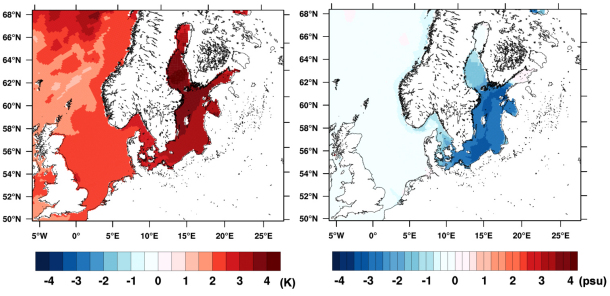
Abb. 4 Änderungen der mittleren Meeresoberflächentemperatur (sea surface temperature - SST, links) und des Salzgehalts an der Meeresoberfläche (sea surface salinity- SSS, rechts) zwischen den Zeitscheibenn 2080-2099 und 1980-1999
Nahezu alle globalen AOGCMs, die für IPCC-Szenarienläufe verwendet werden, sind viel zu grob aufgelöst und daher nicht in der Lage, realistische Salzkonzentrationen für die Ostsee zu simulieren. Alle globalen AOGCMs zeigen daher auch keine klimainduzierten Änderungen der Dichte und der Schichtung der Wassersäule. In der Simulation des gekoppelten Systems REMO/MPIOM erhalten wir am Ende des 21. Jh. eine starke Versüßung der Ostsee (ca. 3 – 3.5 psu; practical salinity units).
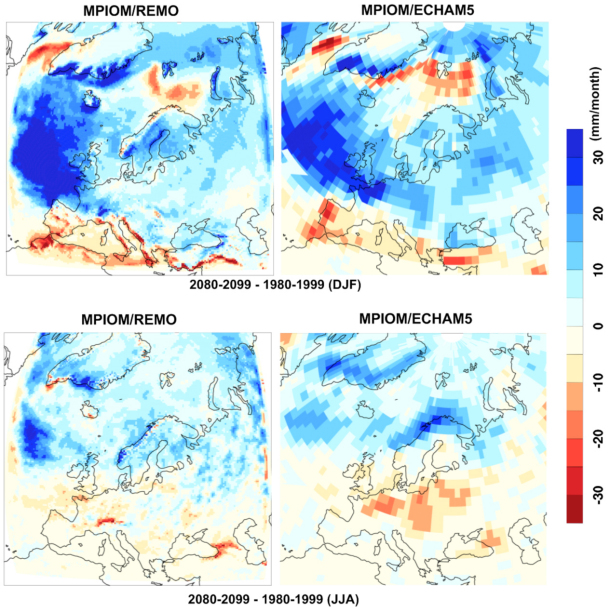
Abb. 5 Änderungen der Winter – (oben) und Sommerniederschläge (unten) simuliert mit REMO/MPIOM (links) und mit ECHAM5/MPIOM (rechts) berechnet.
Zu erklären ist dies mit dem simulierten Anstieg der Winterniederschläge im Einzugsgebiet der baltischen Meeresregion (Abb. 5). Da der Austausch mit dem salzhaltigen Wasser der angrenzenden Nordsee stark durch die dänische Meerenge begrenzt ist, führt der zunehmende Abfluss vom Festland, also der Flüsse, die in die Ostsee münden, zu einer kontinuierlichen Versüßung der Ostsee (s. Abb. 4, rechts).
Bildvergrößerung
Dr. Dmitry Sein
Alfred Wegener Institut (AWI), Bremerhaven
- Dinesh, A.S., Kumar, P., Mishra, A.K., Pandey, L.K., Tewari, M., Cabos, W., Sein, D.V. (2024) Analyzing future marine cold spells in the tropical Indian Ocean: Insights from a regional Earth system model. Quarterly Journal of the Royal Meteorological Society, 1–18. https://doi.org/10.1002/qj.4664
- Tamoffo, A. T., Weber, T., Cabos, W., Sein, D. V., Dosio, A., Rechid, D., et al. (2024). Mechanisms of added value of a coupled global ocean-regional atmosphere climate model over Central Equatorial Africa. Journal of Geophysical Research: Atmospheres, 129, e2023JD039385. https://doi.org/10.1029/2023JD039385
- Sein, D.V., Martyanov, S.D., Dvornikov, A.Y. et al. Future climate change in the Northern Indian Ocean as simulated with a high-resolution regional earth system model. (2023) Clim Dyn, doi: 10.1007/s00382-023-06939-9
- Parras-Berrocal, I. M., Vázquez, R., Cabos, W., Sein, D. V., Álvarez, O., Bruno, M., and Izquierdo, A.: Dense water formation in the eastern Mediterranean under a global warming scenario (2023), Ocean Sci., 19, 941–952, doi: 10.5194/os-19-941-2023.
- Xu, J., Zhi, X., Sein, D. V., Cabos, W., Luo, Y., Zhang, L., et al. (2023). Predictability of coastal boundary layer jets in South China using atmosphere–ocean coupling. Journal of Geophysical Research: Atmospheres, 128, e2023JD039184. doi: 10.1029/2023JD039184
- Vázquez, R., Parras-Berrocal, I.M., Koseki, S., Cabos, W., Sein, D.V., Izquierdo, A. (2023) Seasonality of coastal upwelling trends in the Mauritania-Senegalese region under RCP8.5 climate change scenario, Science of The Total Environment, 898, 166391, ISSN 0048-9697, doi: 10.1016/j.scitotenv.2023.166391
- Sein, D. V., Dvornikov, A. Y., Martyanov, S. D., Cabos, W., Ryabchenko, V. A., Gröger, M., Jacob, D., Kumar Mishra, A., and Kumar, P. (2022): Indian Ocean marine biogeochemical variability and its feedback on simulated South Asia climate, Earth Syst. Dynam., 13, 809–831, doi: 10.5194/esd-13-809-2022
- Kumar, P., Mallick, S., Mishra, A.K., Dubey, A.K., Tiwari, G., Sein, D.V., Cabos, W. and Jacob, D. (2022), Regional Earth System Model for CORDEX-South Asia: a comparative assessment of RESM and ESM over the tropical Indian Ocean. Int J Climatol. https://doi.org/10.1002/joc.7806
- Weber, T., Cabos, W., Sein, D.V., Jacob, D. (2022) Benefits of simulating precipitation characteristics over Africa with a regionally-coupled atmosphere–ocean model. Clim Dyn (2022). https://doi.org/10.1007/s00382-022-06329-7
- Falquina, R., de la Vara, A., Cabos, W., Sein, D.V., Gallardo, C. (2022): Impact of ocean-atmosphere coupling on present and future Köppen-Geiger climate classification in Europe, Atmospheric Research, doi: 10.1016/j.atmosres.2022.106223
- Reale, M., Cabos Narvaez, W.D., Cavicchia, L., Conte, D., Coppola, E., Flaounas, E., Giorgi, F., Gualdi, S., Hochman, A., Li, L., Lionello, P., Podrascanin, Z., Salon, S., Sanchez-Gomez, E., Scoccimarro, E., Sein, D. V., and Somot, S. (2022): Future projections of Mediterranean cyclone characteristics using the Med-CORDEX ensemble of coupled regional climate system models. Clim Dyn 58, 2501–2524, doi: 10.1007/s00382-021-06018-x
- Mishra, A. K., Kumar, P., Dubey, A. K., Jha, S. K., Sein, D. V., Cabos, W. (2022): Demonstrating the asymmetry of the Indian Ocean Dipole response in regional earth system model of CORDEX-SA. (2022): Atmospheric Research, doi: 10.1016/j.atmosres.2022.106182
- Mishra, A. K., Kumar, P., Dubey, A. K.,Towati, G., Sein, D. V. (2022): Impact of air–sea coupling on the simulation of Indian summer monsoon using a high-resolution Regional Earth System Model over CORDEX-SA. Clim. Dyn. doi:10.1007/s00382-022-06249-6
- Gröger, M., Dieterich, C., Dutheil, C., Meier, H. E. M., and Sein, D. V. (2022): Atmospheric rivers in CMIP5 climate ensembles downscaled with a high-resolution regional climate model, Earth Syst. Dynam., 13, 613–631, doi: 10.5194/esd-13-613-2022, 2022
- Parras-Berrocal, I.M., Vázquez, R., Cabos, W., Sein, D.V., Álvarez, O., Bruno, M., Izquierdo, A. (2022): Surface and Intermediate Water Changes Triggering the Future Collapse of Deep Water Formation in the North Western Mediterranean. Geophysical Research Letters, 49 (4), e2021GL095404, doi: 10.1029/2021GL095404
- De La Vara, A., Parras-Berrocal, I.M., Izquierdo, A., Sein, D.V., Cabos, W. (2022): Climate change signal in the ocean circulation of the Tyrrhenian Sea. Earth System Dynamics, 13 (1), pp. 303-319. doi: 10.5194/esd-13-303-2022
- Kumar, P., Mishra, A.K., Dubey, A.K., Javed, A., Saharwardi, M.S., Kumari, A., Sachan, D., Cabos, W., Jacob, D., Sein, D.V. (2022): Regional earth system modelling framework for CORDEX-SA: an integrated model assessment for Indian summer monsoon rainfall. Climate Dynamics. doi: 10.1007/s00382-022-06217-0
- Vazquez, R., Parras-Berrocal, I., Cabos, W., Sein, D.V., Mañanes, R., Izquierdo, A. (2022): Assessment of the Canary current upwelling system in a regionally coupled climate model. Climate Dynamics, 58 (1-2), pp. 69-85. doi: 10.1007/s00382-021-05890-x
- Sein D. V., Dvornikov A. Yu., Martyanov S. D., Cabos W., Ryabchenko V. A., Gröger M., Mishra A. K., Kumar P., Gorchakov V. A. (2021): Influence of the Water Temperature–Phytoplankton Feedback on the Upper Layer Temperature of the IndianOcean. Fundamentalnaya i Prikladnaya Gidrofizika, 14, 4, 64–76. doi: 10.7868/S2073667321040067
- Lima, D. C. A. , Soares, P. M. M. , Cardoso, R. M. , Semedo, A. , Cabos, W. and Sein, D. V. (2021): The present and future offshore wind resource in the Southwestern African region , Climate Dynamics, 56 (5 6), pp. 1371 1388 . doi: 10.1007/s00382-020-05536-4
- Gutierrez‐Fernandez, J. , Gonzalez‐Aleman, J. J. , Vara, A. , Cabos, W. , Sein, D. V. and Gaertner, M. (2021): Impact of ocean–atmosphere coupling on future projection of Medicanes in the Mediterranean Sea, International Journal of Climatology, 41 (4), pp. 2226 2238. doi: 10.1002/joc.6955
- Mishra, A. K. , Kumar, P. , Dubey, A. K. , Javed, A. , Saharwardi, M. S. , Sein, D. V. , Martyanov, S. D. and Jacob, D. (2021): Impact of horizontal resolution on monsoon precipitation for CORDEX South Asia: A regional earth system model assessment , Atmospheric Research, 259 . doi: 10.1016/j.atmosres.2021.105681
- De la Vara, A. , Cabos, W. , Sein, D. V. , Teichmann, C. and Jacob, D. (2021): Impact of air–sea coupling on the climate change signal over the Iberian Peninsula , Climate Dynamics . doi: 10.1007/s00382-021-05812-x
- Cabos Narvaez, W. D., de la Vara, A., Álvarez-García, F. J., Sánchez, E., Sieck, K., Pérez-Sanz, J. I., Limareva, N. and Sein, D. V. (2020) Impact of ocean-atmosphere coupling on regional climate: the Iberian Peninsula case, Climate Dynamics, 54 (9-10), pp. 4441-4467. https://doi.org/10.5194/gmd-13-4595-2020
- Parras-Berrocal, I. M., Vazquez, R., Cabos, W., Sein, D., Mañanes, R., Perez-Sanz, J., and Izquierdo, A., (2020). The climate change signal in the Mediterranean Sea in a regionally coupled atmosphere–ocean model, Ocean Science, 16, 743–765, https://doi.org/10.5194/os-16-743-2020
- Sein, D. V., Groeger, M., Cabos, W., Alvarez-Garcia, F. J., Hagemann, S., Pinto, J. G., Izquierdo, A., de la Vara, A., Koldunov, N. V., Dvornikov, A. Y., Limareva, N., Alekseeva, E., Martinez-Lopez, B. and Jacob, D. (2020) Regionally coupled atmosphere - ocean - marine biogeochemistry model ROM: 2. Studying the climate change signal in the North Atlantic and Europe., Journal of Advances in Modeling Earth Systems, https://doi.org/10.1029/2019MS001646
- Soto-Navarro, J., Jordá, G., Amores, A., Cabos, W., Somot, S., Sevault, F., Macías, D., Djurdjevic, V., Sannino, G., Li, L., Sein, D. V. (2020) Evolution of Mediterranean Sea water properties under climate change scenarios in the Med-CORDEX ensemble. Climate Dynamics, 54, 2135–2165. https://doi.org/10.1007/s00382-019-05105-4
- Tangang, F., Chung, J. X., Juneng, L., Supari, S., Salimun, E., Ngai, S. T., Jamaluddin, A. F., Mohd, M. S. F., Cruz, F., Narisma, G., Santisirisomboon, J., Ngo-Duc, T., Van Tan, P., Singhruck, P., Gunawan, D., Aldrian, E., Sopaheluwakan, A., Grigory, N., Remedio, A. R. C., Sein, D. V., Hein-Griggs, D., McGregor, J. L., Yang, H., Sasaki, H. and Kumar, P. (2020) Projected future changes in rainfall in Southeast Asia based on CORDEX–SEA multi-model simulations, Climate Dynamics. https://doi.org/10.1007/s00382-020-05322-2
- de la Vara, A., Cabos, W., Sein, D. V. et al., (2020). On the impact of atmospheric vs oceanic resolutions on the representation of the sea surface temperature in the South Eastern Tropical Atlantic. Climate Dynamics, 54, 4733–4757. https://doi.org/10.1007/s00382-020-05256-9
- Zhu, S., Remedio, A. R. C., Sein, D. V., Sielmann, F., Ge, F., Xu, J., Peng, T., Jacob, D., Fraedrich, K. and Zhi, X. (2020) Added value of the regionally coupled model ROM in the East Asian summer monsoon modeling, Theoretical and Applied Climatology. doi: https://doi.org/10.1007/s00704-020-03093-8
- Zhu, S., Ge, F., Sielmann, F., Pan, M., Fraedrich, K., Remedio, A. R. C., Sein, D. V., Jacob, D., Wang, H. and Zhi, X. (2020). Seasonal temperature response over the Indochina Peninsula to a worst-case high-emission forcing: a study with the regionally coupled model ROM, Theoretical and Applied Climatology. doi: https://doi.org/10.1007/s00704-020-03345-7
- Akperov, M., Rinke, A., Mokhov, I. I., Semenov, V. A., Parfenova, M. R., Matthes, H., Adakudlu, M., Boberg, F., Christensen, J. H., Dembitskaya, M. A., Dethloff, K., Fettweis, X., Gutjahr, O., Heinemann, G., Koenigk, T., Koldunov, N. V., Laprise, R., Mottram, R., Nikiéma, O., Sein, D., Sobolowski, S., Winger, K. and Zhang, W. (2019) Future projections of cyclone activity in the Arctic for the 21st century from regional climate models (Arctic-CORDEX), Global and Planetary Change, 182, p. 103005. https://doi.org/10.1016/j.gloplacha.2019.103005
- Tian, D., Su, J., Zhou, F., Mayer, B., Sein, D., Zhang, H., Huang, D. and Pohlmann, T. (2019) Heat budget responses of the Eastern China Seas to global warming in a coupled atmosphere–ocean model, Climate Research. https://doi.org/10.3354/cr01579
- Lima, D. C., Soares, P. M., Semedo, A., Cardoso, R. M., Cabos, W. and Sein, D. V. (2019) How will a warming climate affect the Benguela coastal low‐level wind jet?, Journal of Geophysical Research: Atmospheres. https://doi.org/10.1029/2018JD029574
- Darmaraki, S., Somot, S., Sevault, F., Nabat, P., Cabos Narvaez, W. D., Cavicchia, L., Djurdjevic, V., Li, L., Sannino, G. and Sein, D. V. (2019) Future evolution of Marine Heatwaves in the Mediterranean Sea, Climate Dynamic. https://doi.org/10.1007/s00382-019-04661-z
- Parras-Berrocal, I., Vazquez, R., Cabos, W., Sein, D., Mañanes, R., Perez-Sanz, J. and Izquierdo, A. (2019) The climate change signal in the Mediterranean Sea in a regionally coupled atmosphere-ocean model, Ocean Science, 16, 743–765, 2020 doi: 10.5194/os-16-743-2020
- Soares, P., Lima, D. C.A., Semedo, A., Cabos Narvaez, W. D., Sein, D. V. (2019) Climate change impact on the Northwestern African offshore wind energy resources. Environmental Research Letters, doi: 10.1088/1748-9326/ab5731
- Xu, J., Koldunov, N. V., Remedio, A. R. C., Sein, D. V., Rechid, D., Zhi, X., Jiang, X., Xu, M., Zhu, X., Fraedrich, K. and Jacob, D. (2018) Downstream effect of Hengduan Mountains on East China in the REMO regional climate model, Theoretical and Applied Climatology. doi: https://doi.org/10.1007/s00704-018-2721-0
- Lima, D. C. A., Soares, P. M. M., Semedo, Á., Cardoso, R. M., Cabos, W. and Sein, D. V. (2018) A Climatological Analysis of the Benguela Coastal Low‐Level Jet, Journal of Geophysical Research: Atmospheres. doi: https://doi.org/10.1029/2018JD028944
- Soares, P. M. M., Lima, D. C. A., Semedo, A., Cardoso, R. M., Cabos, W. and Sein, D. V. (2018) Assessing the climate change impact on the North African offshore surface wind and coastal low-level jet using coupled and uncoupled regional climate simulations, Climate Dynamics. doi: https://doi.org/10.1007/s00382-018-4565-9
- Soares, P. M. M., Lima, D. C. A., Semedo, Á., Cardoso, R. M., Cabos, W. and Sein, D. V. (2018) The North African coastal low level wind jet: a high resolution view, Climate Dynamics. doi: https://doi.org/10.1007/s00382-018-4441-7
- Sein, D. V., Koldunov, N. V., Danilov, S., Sidorenko, D., Wekerle, C., Cabos, W., Rackow, T., Scholz, P., Semmler, T., Wang, Q. and Jung, T. (2018). The Relative Influence of Atmospheric and Oceanic Model Resolution on the Circulation of the North Atlantic Ocean in a Coupled Climate Model. Journal of Advances in Modeling Earth Systems. doi:10.1029/2018MS001327
- Tangang, F., Supari, S., Chung, J. X., Cruz, F., Salimun, E., Ngai, S. T., Juneng, L., Santisirisomboon, J., Santisirisomboon, J., Ngo-Duc, T., Phan-Van, T., Narisma, G., Singhruck, P., Gunawan, D., Aldrian, E., Sopaheluwakan, A., Nikulin, G., Yang, H., Remedio, A. R. C., Sein, D. V. and Hein-Griggs, D. (2018). Future changes in annual precipitation extremes over Southeast Asia under global warming of 2°C. APN Science Bulletin, 8 (1). doi:10.30852/sb.2018.436
- Xu, J., Koldunov, N., Remedio, A. R. C., Sein, D. V., Zhi, X., Jiang, X., Xu, M., Zhu, X., Fraedrich, K. and Jacob, D. (2018). On the role of horizontal resolution over the Tibetan Plateau in the REMO regional climate model. Climate Dynamics. doi:10.1007/s00382-018-4085-7
- Akperov, M., Rinke, A., Mokhov, I. I., Matthes, H., Semenov, V. A., Adakudlu, M., Cassano, J., Christensen, J. H., Dembitskaya, M. A., Dethloff, K., Glisan, J., Gutjahr, O., Heinemann, G., Koenigk, T., Koldunov, N., Laprise, R., Mottram, R., Nikiéma, O., Scinocca, J. F., Sein, D. V., Sobolowski, S., Winger, K. and Zhang, W. (2018). Cyclone activity in the Arctic from an ensemble of regional climate models (Arctic CORDEX). Journal of Geophysical Research: Atmospheres, 123. doi:10.1002/2017JD027703
- Cabos, W., Sein, D. V., Durán-Quesada, A., Liguori, G., Koldunov, N. V., Martínez-López, B., Alvarez, F., Sieck, K., Limareva, N. and Pinto, J. G. (2018). Dynamical downscaling of historical climate over CORDEX Central America domain with a regionally coupled atmosphere–ocean model. Climate Dynamics. doi:10.1007/s00382-018-4381-2
- Sein, D. V., Koldunov, N. V., Danilov, S., Wang, Q., Sidorenko, D., Fast, I., Rackow, T., Cabos, W. and Jung, T. (2017). Ocean Modeling on a Mesh With Resolution Following the Local Rossby Radius, Journal of Advances in Modeling Earth Systems, 9, 2601–2614 doi:10.1002/2017MS001099
- Paeth, H., Paxian, A., Sein, D.V, Jacob, D., Panitz, H. J., Warscher, M., Fink, A., Kunstmann, H., Breil, M., Engel, T., Krause, A., Tödter, J. and Ahrens, B. (2017), Decadal and multi-year predictability of the West African monsoon and the role of dynamical downscaling, Meteorologische Zeitschrift. doi:10.1127/metz/2017/0811
- Cabos, W., Sein, D. V., Pinto, J. G., Fink, A.H., Koldunov, N.V., Alvarez, F., Izquierdo, A., Keenlyside, N. and Jacob, D. (2016), The South Atlantic Anticyclone as a key player for the representation of the tropical Atlantic climate in coupled climate models, Climate Dynamics. doi: 10.1007/s00382-016-3319-9
- Paxian, A., Sein, D.V., Panitz, H. J., Warscher, M., Breil, M., Engel, T., Tödter, J., Krause, A., Cabos Narvaez, W., Fink, A., Ahrens, B., Kunstmann, H., Jacob, D. and Paeth, H. (2016), Bias reduction in decadal predictions of West African monsoon rainfall using regional climate models, Journal of Geophysical Research-Atmospheres. doi: 10.1002/2015JD024143
- Gaertner, M.Á., González-Alemán, J.J., Romera, R., Domínguez, M. Gil, V., Sánchez, E., Gallardo, C., Miglietta, M.M., Walsh, K.J.E., Sein, D.V., Somot, S., Dell’Aquila, A., Teichmann, C., Ahrens, B., Buonomo, E., Colette, A., Bastin, S., van Meijgaard, E. and Nikulin, G. (2016), Simulation of medicanes over the Mediterranean Sea in a regional climate model ensemble: impact of ocean–atmosphere coupling and increased resolution, Climate Dynamics. doi: 10.1007/s00382-016-3456-1
- Niederdrenk, A. L., Sein, D.V and Mikolajewicz, U. (2016), Interannual variability of the Arctic freshwater cycle in the second half of the twentieth century in a regionally coupled climate model, Climate Dynamics. doi: 10.1007/s00382-016-3047-1
- Sein, D. V., U. Mikolajewicz, M. Gröger, I. Fast, W. Cabos, J. G. Pinto, S. Hagemann, T. Semmler, A. Izquierdo, and D. Jacob (2015), Regionally coupled atmosphere-ocean-sea ice-marine biogeochemistry model ROM: 1. Description and validation, J. Adv. Model. Earth Syst., 7, 268–304, doi: 10.1002/2014MS000357
- Gómez, G., Cabos, W. D., Liguori, G., Sein, D., Lozano-Galeana, S., Fita, L., Fernández, J., Magariño, Mí. E., Jiménez-Guerrero, P., Montávez, J. P., Domínguez, M., Romera, R., and Gaertner, M. Á. (2015), Characterization of the wind speed variability and future change in the Iberian Peninsula and the Balearic Islands. Wind Energ., doi: 10.1002/we.1893
- Sein D.V., Koldunov, N., Pinto J.G., Cabos, W. (2014) Sensitivity of simulated regional Arctic climate to the choice of coupled model domain. Tellus A: Dynamic Meteorology and Oceanography, 66:1, doi: 10.3402/tellusa.v66.23966
- Su J., D.V. Sein, Mathias M., Mayer B., O'Driscoll K., Chen X., Mikolajewicz U., Pohlmann T. (2014) Marine downscaling the global hindcast to the North Sea: a comparison of a global and a regional ocean model simulations. Tellus A 2014, 66, 23927, http://dx.doi.org/10.3402/tellusa.v66.23927
- Mikolajewicz.,U., D.V. Sein, D. Jacob, T. Kahl, R. Podzun, T. Semmler. (2005) Simulating Arctic sea ice variability with a coupled regional atmosphere-ocean-sea ice model. Meteorologische Zeitschrift, 14, No. 6, pp.793-800
- Aldrian E., D.V.Sein, D.Jacob, L.D.Gates and R.Podzun (2005) Modelling of Indonesian Rainfall with a Coupled Regional Model. Climate Dynamics 25, pp. 1–17, DOI 10.1007/s00382-004-0483-0

